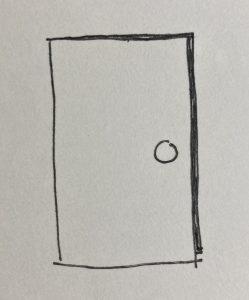Assignment X: When The Library Welcomes You Home

How To Trust The World – With This
I’ve always been drawn to building systems—rules, structures, and safety nets designed to make things play out as expected. So when I read about libraries so deeply built on trust—spaces where the doors stay open, even without a librarian, and users shape the structure—I felt both drawn in and repelled. A part of me understood it instantly. Another part rejected it.
I’ve never fully trusted anyone. It’s hard to imagine doing so in a world where so much can go wrong. And yet, I want to believe in it. I know the power it could hold.
A Library Without A Librarian
I dreamed of a den by a riverbank, full of shoes for sale, and no one there to take the money. An honor system. A space that worked through mutual respect. Not a service, but a shared ritual.
“There are rules, but they are not always written down. The place has a memory of its own.” (Morgenstern, 2019)
What would it mean for a library to trust like that? To be open, unguarded, ready. To trust you to take only what you need, respect the space—and trusts it will hold even if you don’t.
A trust-based library lets go of control. It doesn’t rely on surveillance and rules with punishments. It’s a system that listens and adapts to its users – and changes with them.
“Nothing is locked because it does not need to be. It is not theft if it is meant to be shared.” (Morgenstern, 2019)
Systems That Trust
“We created them, shaped them, trained them, and now we’re surprised that they want something we didn’t plan for.” (Chiang, 2019)
We build systems—platforms, networks, libraries—and try to control them. But, systems made for people get remade by people. When a system is meant to grow with its users, that’s when it becomes real.
“If [it] is to exist, it has to remain free. That’s the nature of thought. It’s not a closed system. It’s not supposed to be owned.” (Thomas, 2006)
We fear letting go, but control is its own kind of collapse. Trust, access, and needs aren’t fixed, but ongoing. Like health, like time, like care. They require maintenance, and that maintenance is a form of trust.
We have to understand the library as more than its brand—more than books, rules, and shushing.
Curiosity as Structure
“There is no more intimate act than play, even between strangers. In play, there is trust. In play, there is intimacy. In play, there is grace.” (Zevin, 2022)
It’s my curiosity that thrives in this world where others wither, I know – it’s what makes me curious about my fears, examine them, engage with, and even attempting to befriend them. I think this is a crucial part of change many, including myself, find challenging to face. But, it’s a vital part of living and learning and building safe spaces and community. Because the world is never perfect, is never unchanging, is never static and peaceful and fearless to face, and there are always problems, new things to fear, new unknowns, new facts, rewritten facts, and endless possibilities.
I say this and I can’t help but think of art – the space of endless possibilities. I think of art, where people stop asking permission. Where letting go creates more room: for creativity, for change, for others.
Empathy; The Shape of Belonging
“The past could be jettisoned, but it never went away. It would always exist. Even if forgotten, it would still be there, moving below the surface.” (Levithan, 2013)
I keep returning to questions of empathy. Especially in my work exploring non-humans—animals, trees, AI, more. So often, we control what we don’t understand. We assume it’s lesser. But that same dynamic plays out human to human, too. If we fail to treat non-humans as equal, it only reflects how we never learned to do so within our own species. So let’s start there.
I’ve never been fully held by a system. Many haven’t. It makes it all the more important we make ones that do.
The Walking Library
In the end, we are each walking libraries—roaming, hyperlinking, connecting. The library grows every time we make space for someone to exist. That’s what a successful system looks like: not one that controls, but one that expands.
Any connection made is an expansion, and a hyperlinking library system in action. The more we connect, and the more we make space for this, the more we make space for everyone to connect, exist, and learn with each other – the more a library system expands and successfully thrives.
This is what I know for certain.
So how do we make space for this? How do we make so much space for this? That is what a successful library system looks like.
– Echo.exe / Alder @echolinked
Resources:
Buckland, M. (1999). Redesigning library services: A manifesto. American Library Association.
Casey, M. E., & Savastinuk, L. C. (2007). Library 2.0: A guide to participatory library service. Information Today.
Chiang, T. (2019). Exhalation: Stories. Alfred A. Knopf.
Levithan, D. (2013). Two boys kissing. Alfred A. Knopf.
Mattern, S. (2014). Library as infrastructure. Places Journal. https://placesjournal.org/article/library-as-infrastructure/
Morgenstern, E. (2019). The starless sea. Doubleday.
Schneider, K. G. (2006). The user is not broken: A meme masquerading as a manifesto. Free Range Librarian. https://freerangelibrarian.com/2006/05/24/the-user-is-not-broken-a-meme-masquerading-as-a-manifesto/
Stephens, M. (2016). The heart of librarianship: Attentive, positive, and purposeful change. ALA Editions.
Stephens, M. (2019). Wholehearted librarianship: Finding hope, inspiration, and balance. ALA Editions.
Thomas, S. (2006). The end of Mr. Y. Harvest Books.
Weinberger, D. (2001). The hyperlinked organization. In The Cluetrain manifesto (pp. 86–123). Perseus Books.
Zevin, G. (2022). Tomorrow, and tomorrow, and tomorrow. Alfred A. Knopf.
Zusak, M. (2005). The book thief. Alfred A. Knopf.